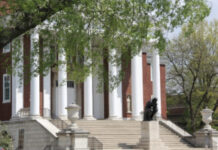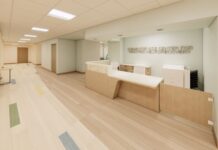“We have a very special partnership with Kosair Charities as we both seek to improve the lives of the children of our region and beyond,” said Dr. James Ramsey, president of the University of Louisville. “It is appropriate that the Kosair Charities’ name adorn the building that epitomizes our goal of moving research from bench to bedside. Kosair Charities is helping us understand so many health care issues that face our children and determine ways to resolve those issues. As I have said so many times before, the children of our area have no better friend than Kosair Charities.”
“This is a tremendous honor for all of us associated with Kosair Charities,” said Jerry Ward, chair of the board of Kosair Charities. “The University of Louisville has been working side by side with Kosair Charities for 90 years. This partnership has advanced the mission of Kosair Charities as we work towards improving outcomes for children suffering from pediatric cancer, heart disease, and now spinal cord injury, through our support of the University of Louisville’s research initiatives. We look forward to changing the lives of children through discovery and innovation produced in this premier research facility.”
Over the years, Kosair Charities has provided more than $42.5 million in support of programs at the University of Louisville.
The work that takes place within the Kosair Charities Clinical and Translational Research Building has the potential to transform people’s lives, said Dr. David L. Dunn, executive vice president for health affairs at UofL. It is an honor to have it named for an organizational that transforms the lives of children throughout Kentucky and beyond.
Opened in 2009, the Kosair Charities Clinical and Translational Research building spans nearly 300,000 square feet and houses researchers exploring ways to prevent, treat and cure diseases that impact people throughout the world. Research activities within the building include:
- The evaluation of alcohol-induced liver injury, obesity-related fatty liver and hepatitis C at the molecular level, in order to develop prevention and intervention strategies
- The development of promising drug therapies and rapidly moving them from the lab to the clinical setting, where they can benefit cancer patients.
- The investigation of lung cancer its molecular level, with the hope of translating the findings into new agents for combating the disease.
Additionally, the building earned LEED Gold status for its sustainability measures, which include:
- A Whole Building Energy Model Simulation was developed to guide decisions toward a more energy efficient building. This performance model results in at least a 21 percent to 24.5 percent energy cost savings to the university as well as conservation of energy supplies.
- All regularly occupied rooms have occupant controlled lighting.
- The landscaping and irrigation systems have been designed to reduce water consumption for landscaping by 50 percent and the irrigation water used on site is supplied by a non-potable source a combination of captured condensation in the building air handlers and storm water.



























